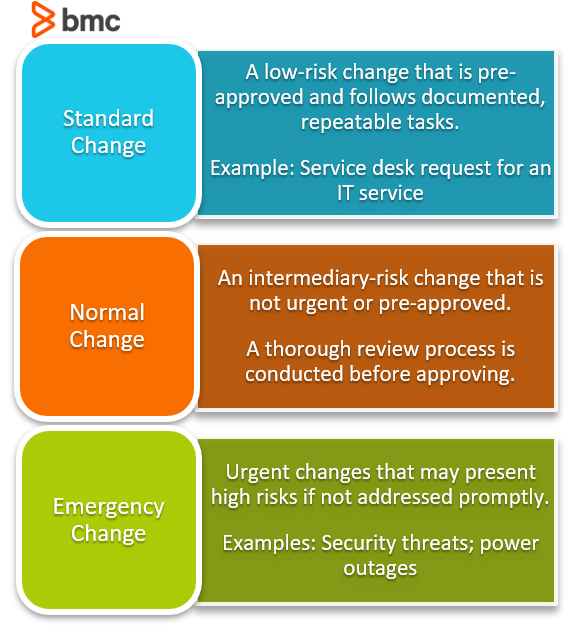Change enablement, also known as change management, is at the core of ITIL® service transition. The maturity of organization depends on how well it facilitates change requests (CR) in response to end-user, technical, functional or wider business requirements.
Careful change management helps reduce the risk exposure and disruption proactively when new changes are instituted within your organization’s operations and technologies.
ITIL provides an effective framework guideline to conduct change enablement and management activities. In this article, we will discuss the key roles and responsibilities involved in change management according to ITIL guidelines. Even if you don’t adhere to the ITIL framework, these roles help clarify your change management processes.
We’ll look at:
- The change manager
- Change advisory board (CAB)
- Emergency CAB
- The change process owner
- Change management teams
Change manager
Change managers are employees leading the change management programs. These leaders have a background in conducting structured change efforts in organizations.
A certification verifying change management skill is typically desired for a change manager, who will be involved in the following key activities:
- Leading the change management activities within a structured process framework.
- Designing the strategic approach to managing change and support operations that fall within the domain of change management.
- Evaluating the change impact and organizational readiness to limit potential risk.
- Supporting training and communication as part of change management. Activities may include designing or delivering specialized training resources to appropriate userbase.
- Evaluating the risk of change and providing actionable guidelines on reducing the impact.
- Evaluating resistance in adopting the change at the user, process, and technology level.
- Managing the change portfolio, which allows the organization to prepare for and successfully adopt the change.
- Authorize minor change requests and coordinate with the Change Advisory Board for changes presenting higher risk.
- Conduct post-implementation reviews to assess the decisions and performance related to the change request.
Change Advisory Board (CAB)
This is the team that controls the lifecycle of change across all processes as specified within ITIL Service Transition function. The Change Advisory Board involves high-level members from different domains, including information security, operations, development, networking, service desk, and business relations, among others.
Together, the CAB is responsible for the following activities:
- Supporting the change manager in decisions for major changes.
- Evaluating Requests for Change (RFCs), the available resources, impact of change, and organizational readiness.
- Validating that appropriate tests and evaluation are performed before high-risk changes are approved.
- Documenting relevant processes and activities.
- Supporting the design of change implementation scheduling.
- Reviewing a change implementation process.
- Supporting the design and approving new change process models.
- Using the diverse knowledge base, skills, and expertise of each CAB member to provide a unique perspective before a decision is finalized.

Emergency Change Advisory Board (ECAB)
The ECAB is a smaller body within the CAB that deals specifically with emergency changes. (Emergency changes are one of three change types according to ITIL.) When the emergency change request is raised, the change manager must conduct a thorough analysis and evaluation before finalizing a decision together with the CAB.
A dedicated ECAB body ensures that the necessary resources and expertise within the CAB is available to make the right decision at the right time. The ECAB is responsible for performing activities as similar to the CAB but focused primarily on emergency changes. These include:
- Assessing the relative importance of the emergency change request.
- Supporting the change manager during impact and risk assessment.
- Reviewing the change request, risk analysis, and impact evaluation before the decision is finalized.
- Approving or rejecting an emergency change.
- Evaluating the efficacy of the emergency change implementation process.
Change process owner
The change process owner can have overlapping responsibilities with the ITIL Process Owner, specifically within the function of change management. (For this reason, a separate change process owner may not be required for small and midsize business organizations.)
The change process owner is responsible for defining and supporting the overall process involved in change management. The activities include:
- Devising the process, in support with the change manager and CAB.
- Communicating the guidelines to appropriate stakeholders.
- Facilitating cross-departmental collaboration necessary for change management.
- Evaluating and improving the change management process.
- Reporting on the performance of the process to CAB and change manager.
- Initiating process improvements.
The change management team
Change management functions are distributed in teams across departments and ITIL functions. Individuals within these teams may be responsible for managing change within a specific organizational unit considering their expertise, skills, and background.
Specific change management teams may consist of three roles:
- Change requestor. The individual responsible for initiating, preparing, and submitting a change request. This person may support collection of the necessary business information and engaging with the concerned stakeholders before the change request is assigned to the change tester. Additionally, the change requestor also works with the change management team to support impact assessment by collecting data and communicating with other stakeholders.
- Change owner/assignee/implementor. The individual deemed as an owner of the CR throughout the request lifecycle. The change tester may also take the role of the Change Requestor and support the process for creating and submitting a change request. The change owner ensures that the necessary tests have been performed so that the change request is followed up by appropriate urgency. The change owner would also document the process across the request life cycle.
- Change approver. The individual responsible for the initial approval of a change request before it is sent to the change manager and CAB for a final decision. The change approver would communicate with other stakeholders and support the documentation before the request is sent to the change manager. This role is also generic and may be occupied by different individuals at various hierarchal levels of the change management framework. At each level, the Change Approver ensures that the change request has reached the necessary standard of readiness to warrant a decision by the change manager and the CAB.







